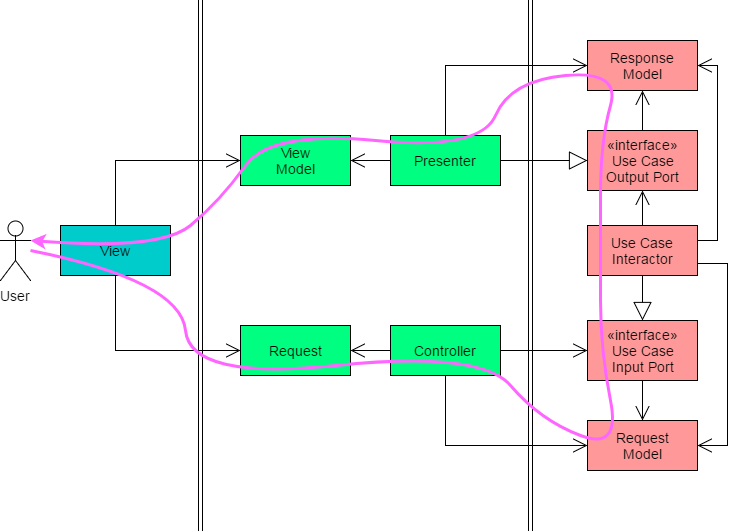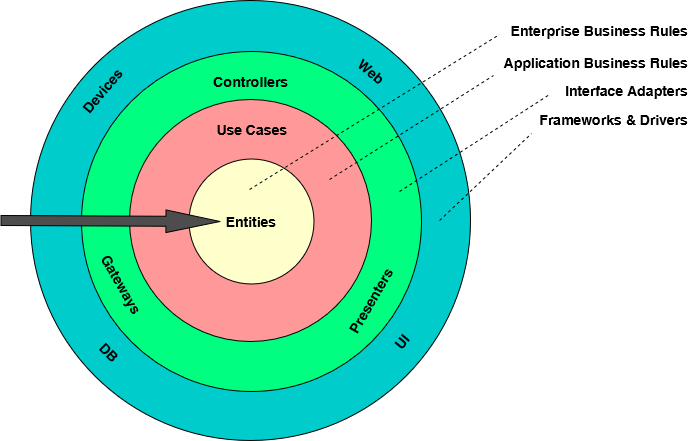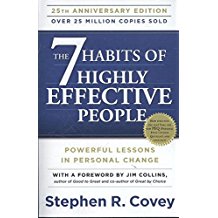20 Feb 2018

Last time we discussed about use cases and interactors and
stopped with the question: “Which role is than actually left to the controller and presenter?”
In this post I will take this question up and dive deeper into the world of controllers and presenters
in the context of the Clean Architecture.
Read on!
18 Feb 2018
While preparing my next post on Implementing Clean Architecture I watched again
Uncle Bobs famous talk on Clean Architecture and Design.
I know it is more than three years old but if you are interested in Clean Architecture you should take your time and
watch it. Uncle Bob explains nicely - and a little bit funny as usual ;-) - what the Clean Architecture is about,
how the puzzle is built up and why it has to be like this.
And as a summary for this video and as an outlook to my next post here is the key message:

13 Feb 2018
Today I found a nice article on the NDepend Blog:
An Introduction To Clean Architecture.
The post gives a nice introduction by first motivating clean architecture by looking at the
short comings of the traditional layered approach. It then gives some history about the Clean Architecture.
Finally the post briefly introduces the Clean Architecture itself - the circles and the dependency rule.
It was a nice read - looking forward to read the follow-ups.
11 Feb 2018

Now that my architecture is screaming the business capabilities
of my system let’s look at those with more detail.
In the Clean Architecture all the application specific business rules go into the use cases circle.
But what is a use case? How big should it be? How does it interact with its environment?
Read on!
04 Feb 2018
How do I make my architecture “scream”?
According to Uncle Bob an architecture “screams” when it clearly expresses its core business purpose.
The top level folder structure, the project/DLL names and the namespaces should express business aspects rather
than frameworks or other details.
Athena is a web application implemented in ASP.NET MVC. But is this important?
I could switch to Ruby on Rails or Node.js - it wouldn’t make any difference for the business.
Why do we let such details impact our project structure so often?
02 Feb 2018
Let’s briefly summarize what the Clean Architecture is …

31 Jan 2018
Did you enjoy reading Uncle Bob’s Clean Architecture?

I did! As with every book from Uncle Bob’s it is motivating and inspiring, right?
So let’s take his ideas and realize these in our projects to gain what he is promising!
But how do I start?
How do I transform an existing code base - following a layered (web) architecture - into the Clean Architecture?

28 Jan 2018
Are you scared of doing presentations? Especially in front of a bigger audience?
You don’t have to! Just don’t do these mistakes …
- Using corporate templates
- Having content packed slides
- Writing full sentences
- Focusing on the slides during presentation
23 Jan 2018
Are you missing readers on your blog? Don’t make this mistake …
… and forget about SEO!
20 Jan 2018
This week I had a discussion with a colleague of mine about stakeholder conform communication.
The content of the discussion reminded me about the “2. Habit: Begin with the end in mind”.
This habit is one of seven from Stephen Convey’s great book
The 7 Habits of Highly Effective People.

19 Jan 2018
Every now and then I come across questions on how to handle dialogs in MVVM pattern with WPF.
Honestly, most of the solution proposals I don’t like as they - from my perspective - somehow
“violate” the MVVM pattern.
Here is how I handle dialogs with MVVM pattern …
13 Jan 2018
Legal and privacy topics don’t have primary focus on a blog but also such topics are important …
12 Jan 2018
Now that I have my basic blog running I want to tune it a little bit …
12 Jan 2018
How did I set up the basics of my blog?
Of course there are endless very good posts out there about Markdown + Jekyll + GitHub Pages and I am not going
to repeat what others already have nicely documented. So let me just summarize my setup and referring to
others for more detailed explanations.
11 Jan 2018
How could one blog the pragmatic, the minimalistic, the “plainionistic” way?
For me the answer is simple: Use the “power of plain text” and write posts in Markdown ;-)






